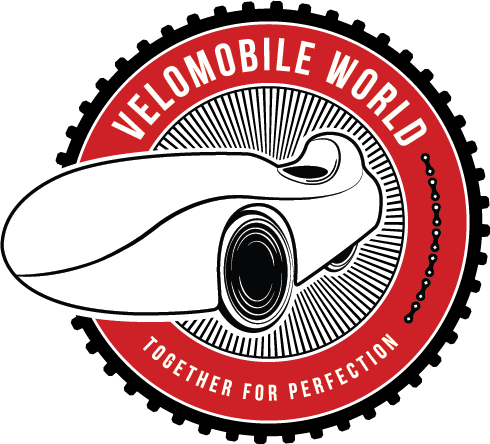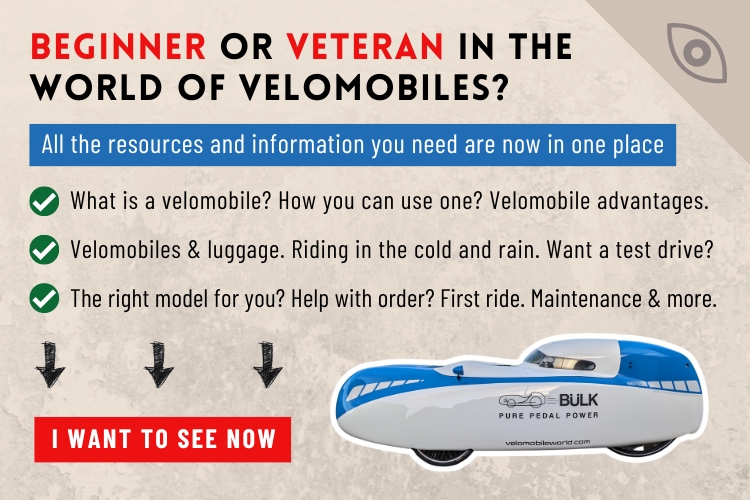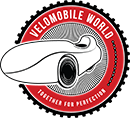......................................................
STORIES FROM VELOMOBILE COMMUNITY
Are There Safe Cycling Options?
Author: BEN PARKE
......................................................


......................................................
If you’ve been watching my channel for a while, you know that I’m a big fan of using bicycles as my primary form of transportation. I’ve uploaded a few videos now on the topic. One of the most common comments I get is “but you have no idea how dangerous it is to cycle where I live!” I hear you on that point. I’ve had exactly the same thought. So, how did I go from driving a car everywhere to cycling everywhere, and is it actually as dangerous as it seems, or are there ways we can find to cycle safely in an area designed entirely with cars in mind?
I live in the inner ring of suburbs around Minneapolis, MN. Now, Minneapolis was just named the best city for cycling in the USA for 2023. If you’ve ever had the privilege to cycle in Minneapolis, you’ll understand why this is. There are countless miles of bike paths separated from the road, a rapidly growing network of on-road cycle lanes, and a recently imposed 20mph speed limit, all of which are designed to help improve safety for cyclists and pedestrians. On any given weekend in the warmer months, you’ll find the trails full of cyclists of all types. However, head a few miles south, and you hit my city. My city has a fraction of the bike paths and lanes that Minneapolis has. In fact, in past years my city has had the highest accident rate of cars hitting cyclists and pedestrians of any suburb of Minneapolis. Both times I’ve been hit by cars happened in my city. So how is it that I’ve managed to cycle thousands of miles here and not get killed?
When I was first thinking about using my velomobile to commute and run errands, I approached it from the perspective of a car driver. I thought of the 4-6 lane roads with 35-45 mph speed limits packed with giant SUVs. Not exactly a cycle friendly environment. However, just because that’s the fastest route in a car, doesn’t mean it’s the fastest or even the best route with a bike or velomobile. There are 15 or so grocery stores within a rideable distance of me. My usual grocery store, the one that’s the closest, is in the middle of a busy commercial area with a huge parking lot with multiple stores. It’s not really a place I want to drive my car, and not any more appealing with a bicycle or velomobile. However, there’s another store in a quieter area not that much further away. Not only is the parking lot less busy, but I can get there using quiet side streets with at most maybe a handful of cars and traffic lights at the few busy road crossings. I found the same for my daily commute. At first I took the route I would take with my car, but by studying the maps I was able to find an alternate route that not only had less traffic, but was also better paved and more scenic. Even destinations stuck right in the middle of busy areas often have back routes with minimal traffic like my chiropractor’s office. Sometimes those back routes can even be faster than driving with your car because you’re not sitting at traffic lights every few blocks. There are a variety of maps that list cycle routes in your area. Pocket Earth (iPhone), Komoot, RidewithGPS, Garmin Connect (Garmin owners only), Strava maps, and Google maps are all great places to search for cycle friendly routes. A lot of these apps also allow you to navigate from them while riding so you don’t have to memorize a new route. And don’t forget you can also consult other local cyclists who often know the hidden routes. Finally, I’ve learned which times of day have the lowest volume of traffic. When possible I choose these times to run my errands. If I’m riding during a busier time, I try to route myself onto quieter streets, partly for sanity, and partly because it’s usually faster and safer.
However, sometimes it’s just not possible to find a cycle-friendly route. That’s where having a velomobile can be a real advantage. While a bicycle cruises perhaps 14-18mph, a velomobile like the Bülk can easily cruise 20-30mph. That means you’re closer to the speed of traffic and feel a little less like a sitting duck. Some velomobile models can even be outfitted with e-assist to help you get up to cruising speed more quickly and zip up hills, though most riders find they really don’t need the extra boost. Velomobiles also have the advantage of being the most fascinating object on the road. A 2.5 meter long brightly colored torpedo zipping down the road has the tendency to get noticed. Throw on some bright flashing lights front and rear, and most drivers will notice you. For the drivers too focused on their phones, there’s the horn. Trust me, it’s effective… On the off chance you do get hit by a car, the shell takes a lot of the hit and dissipates the energy of the crash, much like the body of a car. The cockpit edges act as a sort of seatbelt keeping you from flying out of the bike and across the road, the headbump helps keep your head from hitting the pavement if you flip, there are dedicated crash zones, padded headrests, and so on. I’ve actually been injured worse when I’ve been hit while driving my car than when I was hit in the velomobile this spring by a car that blew a stop sign at 30 mph. Plus, since we’re usually riding streets with lower speed limits, the impact of a crash is also likely to be at lower speeds, which usually means less severe injuries.
When you do find yourself riding on the road, the best advice I was ever given was to take the lane. This might seem counterintuitive. Doesn’t that make you a sitting duck? Actually, no. I have a short 6-lane stretch of road I have to ride to cross a major highway. At first I stayed all the way to the right, but drivers tended to think they had room to pass me without changing lanes. Obviously a lot of drivers are not aware of the 3 foot passing rule. By taking the lane, not only do drivers pull into the other lane, but it also seems to make them more aware of me. I also can’t emphasize enough the importance of bright lights, ideally in a flash mode. The HotSpot, available for most velomobiles sold by Velomobile World, is invaluable. The higher up you can position those bright lights, the better. I also retrofitted a Feniex T3 red flasher in the rear. You would need a nearly blind driver to miss that light. Then there’s the Garmin Varia Radar which will activate a variable flashing pattern depending on how close a driver is and can also show you on a Garmin device when a driver is approaching from behind. Headlights with both a daytime and nighttime mode are great as well, and standard with Velomobile World models. I highly recommend one installed in the front of the HotSpot. The final key to safety is an incident camera system. Sometimes just having a camera visible is enough to get drivers to behave and also gives you something you can send in to the police, or even just to city planners to emphasize the need for safe cycling infrastructure. I actually had the chance to meet with a city cycling planner after sending in some video of close passes. It was a productive meeting that led to some improvements in the areas I ride. There’s also the saying that the squeaky wheel gets the grease. The more of us out cycling and pressing for changes, the more likely it is to happen. Video evidence can really help drive home the need for safer cycling infrastructure. Getting involved with local cycle advocacy groups is another great way to push for change. I think most cities would prefer not to be voted the most unsafe place in the USA for cyclists and pedestrians. The final point in safe cycling on the road, is that there is one instance where you will not be visible to larger vehicles like an SUV: when you are directly next to them. Most of the time they will have approached you from behind and will have some idea of where you are, but once they are up next to you, assume they have forgotten about you. It’s a good idea to let them go ahead of you to the point where you can see them in their mirrors, especially if you’re approaching a street where they might make a turn across the front of you. If I happen to be in front of a giant SUV, I keep an eye on my mirrors and my finger near the horn button just in case they’ve forgotten I’m there. Parked cars are a similar situation, especially if there are driveways or streets with entering vehicles that may not be able to see past those parked cars. Pulling out into the middle of the traffic lane can give a better angle of view for you and entering vehicles. Slowing down and looking carefully past those parked cars is a good idea. Even better is routing onto a different street without parked cars when possible. A flag would be a final option if you are regularly riding in an area with a lot of parked cars, though my experience is that defensive riding and bright lights are likely more effective than a flag.
It’s easy to look at cars, especially giant SUVs, and feel like it’s the only safe way to get from point A to point B. The biggest complaint I hear about velomobiles is that they’re too low to the ground, but so are squirrels, turkeys, geese, small children, potholes, tree limbs, and a whole lot of other things that drivers generally don’t run over. I’ve been hit more times in my car than my velomobile and was actually injured worse each time. A motor vehicle doesn’t guarantee you’ll be seen either. Three of those accidents involved me being rear-ended. Even school buses get hit, which theoretically should be about as visible as you get. The problem is not so much the vehicle we drive or ride, but the growing number of distracted drivers. Taking reasonable precautions no matter what you’re driving, like the combination of routing on lower traffic streets, bright lights, and defensive driving, can make a velomobile just as safe as a car or truck. Throw in the intentionally designed safety features of newer models like the Bülk, and you’ve got as safe a bicycle as you can get. Every year the vehicles in the USA seem to get bigger and less gas efficient. We’re on pace to soon all be driving tanks on the road. Not only does that create more traffic congestion, but it also leads to increased wear and tear on our already crumbling infrastructure, not to mention the escalating cost to own and operate these huge vehicles and the environmental impact from them. The more people that turn to cycling for transportation, or even just walking for shorter trips, the more we can ease the impact of heavy traffic volumes.
I’ve mentioned a few times before about the health benefits I’ve found from cycling. I think that’s a valuable point to bring up again. Fresh air, sunshine, exercise (even with e-assist) are all proven to improve your health mentally and physically. The US is not the only country dealing with an increase in mental and physical health issues. Cycling can have a big positive influence in both of these areas. This has been the biggest change for me since going car-free. I don’t want to drive places anymore. I like the quiet side streets. I like feeling part of the environment as I ride. I like the high I get from a good bike ride. I enjoy the social interactions I have from riding such a unique bike. I don’t want to be just another angry impatient motorist on the road. And I like not paying the high price of gas. A car will never bring me any of those things.
On the face of it, cycling might seem incredibly dangerous. I’ve been there. I’ve dealt with the intimidating feeling of trying to navigate through an area designed entirely for cars without getting killed. It took me some time to make the adjustment in routing and position on the road, but over time my confidence has built and I’ve found it’s not as scary as it seems. Don’t hesitate to ask fellow cyclists for help learning the ropes of cycle commuting. We’re here to help, and a lot of us are very passionate about seeing others discover the joys we have found from cycling. And as always, if you’re interested in taking the plunge into the world of velomobiles, send me a message at "[email protected]" and I’d be happy to help you discover more about this great form of transportation. As always, thanks for watching, remember to like and subscribe, and I’ll see you in the next video!







